For ideal Apple Watch battery health, charge between 40-80% rather than depleting it completely. Your watch uses machine learning to enhance charging patterns, pausing at 80% during overnight charges before reaching 100% when you need it. Avoid extreme temperatures while charging and remove protective cases to prevent overheating. You’ll extend your battery’s lifespan considerably by letting the watch’s intelligent charging system do its work instead of forcing frequent full charges.
The Ideal Charging Range for Apple Watch Battery Longevity
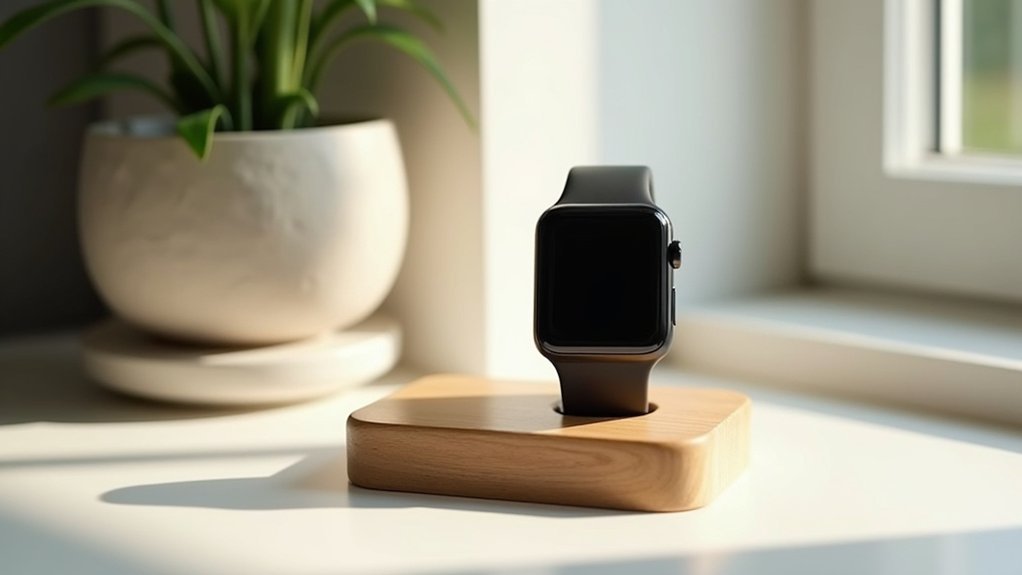
While many Apple Watch users worry about the ideal moment to charge their device, the lithium-ion battery inside doesn’t actually require any specific percentage threshold to begin charging.
For optimal battery longevity, aim to keep your Apple Watch between 40-80% when possible. This range minimizes chemical degradation within battery cells. Apple Watch uses on-device machine learning to optimize battery charging and reduce battery aging over time.
Maintain your Apple Watch between 40-80% charge to minimize battery degradation and maximize long-term performance.
Avoid letting your watch drop below 20%, as low-charge states accelerate capacity loss.
You don’t need to fear partial charging—topping up from 40% to 100% won’t harm your battery. In fact, frequent top-ups are better than deep discharges.
Your watch tracks complete cycles cumulatively, so two 50% charges count as one full cycle.
Understanding Optimized Charging Features on Apple Watch
Apple Watch offers Optimized Battery Charging and Optimized Charge Limit features to help extend your battery’s lifespan by limiting full charges based on your usage patterns.
Your watch learns when to charge to an optimized level versus charging to 100%, indicated by an open charging ring when optimization is active.
You’ll notice these smart charging features work best after your watch has had time to learn your daily routines, though you can always override them when you need a full charge. This technology uses on-device machine learning to predict when you’ll need a full battery, helping reduce battery wear over time.
Understanding Optimized Charging Features on Apple Watch
To extend your Apple Watch’s battery lifespan, newer models come equipped with intelligent charging features that adapt to your daily habits.
The Optimized Charge Limit, available on Apple Watch SE, Series 6 and newer models running watchOS 10+, limits charging to protect battery health.
When active, you’ll notice an open charge ring on your screen. The feature learns your routine and typically stops charging at 80%, completing to 100% only when it predicts you’ll need it. This works best at locations you frequently visit, like home or work. Optimized Battery Charging uses on-device machine learning to predict your charging habits and minimize battery wear.
You can override this by tapping “Charge to Full Now” when needed. While disabling this feature in Battery Health settings might seem convenient, it can greatly reduce your watch’s battery lifespan over time.
How Optimization Works
Behind the scenes of optimized charging lies a sophisticated machine learning system that studies your daily habits and charging patterns. Your Watch gradually adapts to when you typically use and charge your device, dynamically adjusting the charging limit each day rather than following rigid rules.
When you first set up your Apple Watch, it’ll charge to 100% while collecting data about your usage. As it learns, it’ll begin implementing optimization by sometimes charging to only 80% when appropriate, completing the full charge just before you need it. This feature is available on all Apple Watch models running watchOS 7 and later.
- Your Watch intelligently preserves battery health by reducing time spent at full charge
- You’ll notice an open charging ring when optimization is active
- Override is always available when you need a full charge immediately
- The system continually refines itself to better serve your unique patterns
Ring Icon Indicators
Your Apple Watch communicates its charging status through an intuitive system of ring icons and color indicators. When you connect your charger, a red lightning bolt within a ring confirms charging has begun, quickly shifting to a green lightning bolt with a circular animation showing real-time progress.
Contrary to popular belief, the green ring doesn’t indicate a specific percentage—it simply shows active charging. For precise battery levels, press the side button to access Control Center or add battery complications to your watch face. When your watch is locked during charging, you may notice a lock icon displayed alongside the charging indicator until you enter your passcode.
Color indicators serve different purposes: green for normal charging, yellow for Low Power Mode (activated at 10% by default), and red for critically low battery.
The animation speed reflects your charging rate, with Series 7+ models displaying faster movement during rapid charging sessions.
Daily Charging Habits That Extend Battery Lifespan
While many Apple Watch owners focus on battery life per charge, developing smart daily charging habits greatly impacts your device’s overall lifespan.
Apple’s optimized charging feature learns your routine to minimize time spent at 100%, but you can further enhance battery health with consistent practices.
- Charge between uses throughout the day instead of letting your watch drain completely
- Take advantage of overnight charging—the watch will learn to hold at 80% until you’re likely to use it
- Remove protective cases during charging to prevent overheating
- Keep watchOS updated to benefit from the latest battery optimization improvements
Avoiding exposure to high temperatures can significantly extend your battery’s lifespan as heat accelerates chemical aging in lithium-ion batteries.
Remember that lithium-ion batteries typically last 2-3 years, but proper charging habits can maximize their useful life and performance.
When to Override Optimized Charging for Full Power
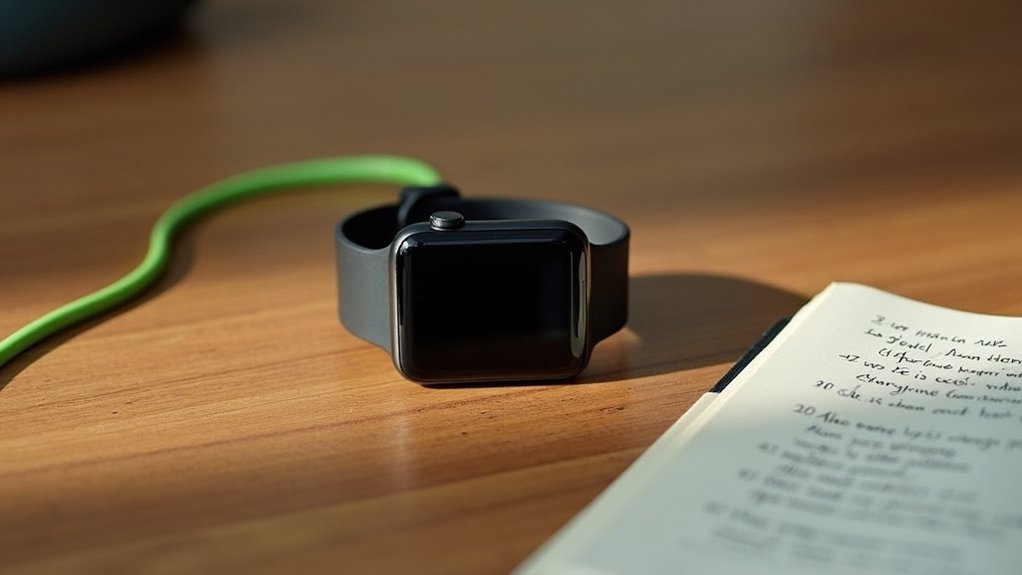
Apple’s optimized charging feature helps preserve battery health, but occasionally you’ll need to override it to assure your watch has 100% power.
Override before travel days, extended events, or when you anticipate needing maximum runtime. If your schedule changes suddenly (like an early meeting) and disrupts your usual charging pattern, manually charging to full assures you won’t run out of power.
Be proactive about charging to 100% before unusual days or schedule changes to ensure your watch lasts when you need it most.
During emergency situations or outdoor activities, a full battery provides peace of mind. The feature works best when you maintain consistent charging schedules, which helps the Watch learn your habits more effectively.
To override, simply place your watch on the charger, tap the charging screen, select the incomplete charge ring, and press “Charge to Full Now.” This typically requires 10-30 additional minutes.
Remember that new watches under two weeks old might need manual intervention while the AI learns your habits.
Temperature Considerations for Apple Watch Battery Health
Temperature plays an essential role in maintaining your Apple Watch battery’s health and longevity. Your device performs best when charged between 32° and 95°F (0° to 35°C), with the Ultra model offering wider operational ranges but still necessitating similar charging conditions.
- Never leave your watch in a hot car – the extreme heat can permanently damage your battery capacity.
- Beware of winter charging – cold temperatures below 32°F reduce battery performance dramatically.
- Watch for temperature warnings on your screen, signaling your device needs to cool down immediately.
- Avoid direct sunlight exposure during charging, which can silently damage your battery over time.
For additional protection against temperature-related issues, your Apple Watch has intelligent systems that may pause charging until normal temperature ranges are restored.
Keeping your Apple Watch at moderate temperatures during charging guarantees maximum battery health and extends its overall lifespan.
Apple Watch Battery Maintenance Through Proper Charging Cycles
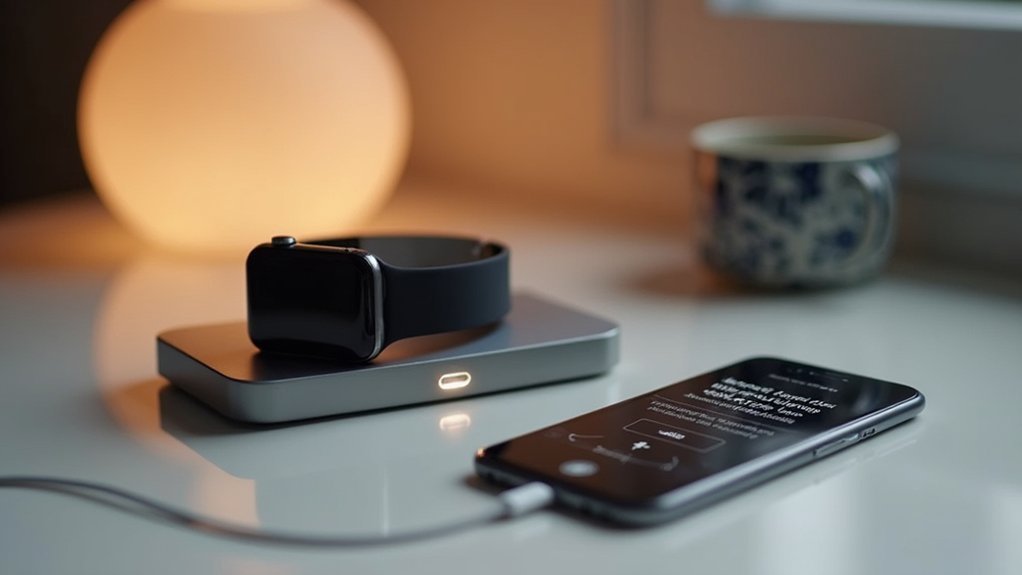
Beyond managing temperature, understanding how to properly cycle your Apple Watch’s battery will greatly extend its lifespan.
Your watch uses machine learning to adapt to your charging habits, optimizing battery health over time.
Instead of frequent top-ups, let your watch leverage its Optimized Battery Charging feature, which intelligently pauses at 80% during routine charges. This helps reduce battery wear from constant full charging.
For newer models, the Optimized Charge Limit feature dynamically adjusts maximum charge levels based on your usage patterns. You can access these features through the Settings app on your Apple Watch by navigating to Battery, then Battery Health.
When you see an open charge ring, it indicates optimized charging is active.
While you can manually request a full charge when needed, it’s best to let your watch’s adaptive technology handle routine charging.
This personalized approach maintains peak performance while minimizing battery degradation over time.
Frequently Asked Questions
Can I Use Third-Party Chargers Without Damaging My Apple Watch Battery?
You can use third-party chargers for your Apple Watch, but choose MFi-certified options only. Non-certified chargers may deliver incorrect voltage, generate excess heat, and damage your battery over time.
Does Airplane Mode Affect Optimal Charging Percentages?
No, airplane mode doesn’t affect ideal charging percentages on your Apple Watch. It only disables wireless connections while your watch continues to optimize battery health using the same charging patterns it’s learned from your usage.
How Does Swimming or Water Exposure Impact Battery Charging Needs?
Swimming doesn’t directly impact charging percentages, but water activities drain your battery faster due to heart rate monitoring and GPS usage. You’ll likely need to charge more frequently after water exposure than usual.
Will Charging Multiple Times Daily Harm My Apple Watch Battery?
No, charging multiple times daily won’t harm your battery if optimized features are enabled. Your Apple Watch adapts to your charging habits, and the optimized charging system helps prevent unnecessary wear on the battery.
Can I Manually Calibrate My Apple Watch Battery if Charging Seems Inaccurate?
No, you don’t need to manually calibrate your Apple Watch battery. If charging seems inaccurate, try restarting your watch or performing a reset. For persistent issues, contact Apple Support for assistance.
In Summary
You’ll maximize your Apple Watch battery life by keeping it between 20% and 80% charged whenever possible. Trust Apple’s optimized charging feature to handle the details, but don’t stress about occasional full charges when needed. Remember that temperature matters—avoid extreme heat or cold. By following these simple charging habits, you’ll considerably extend your watch’s battery lifespan for years to come.

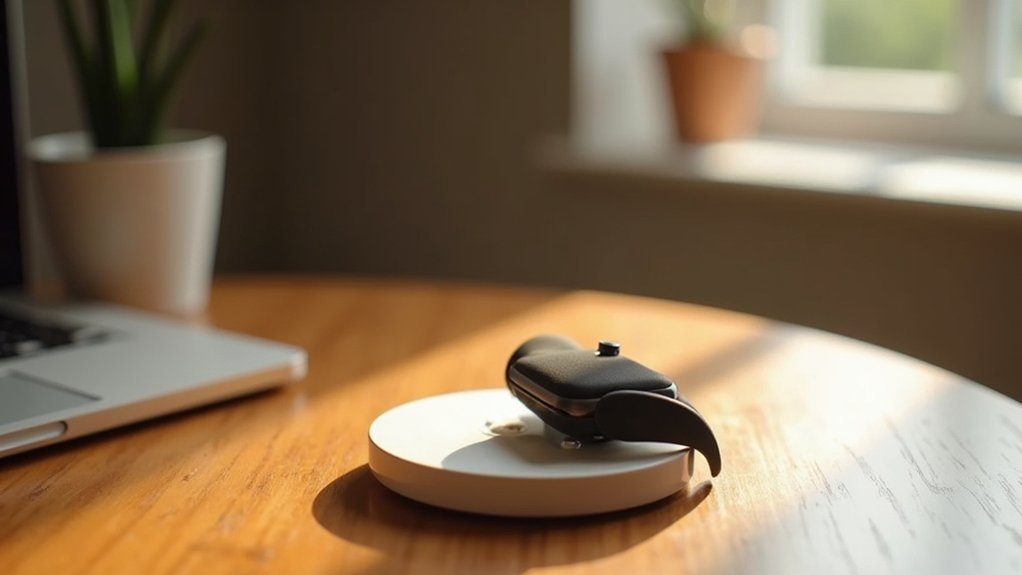

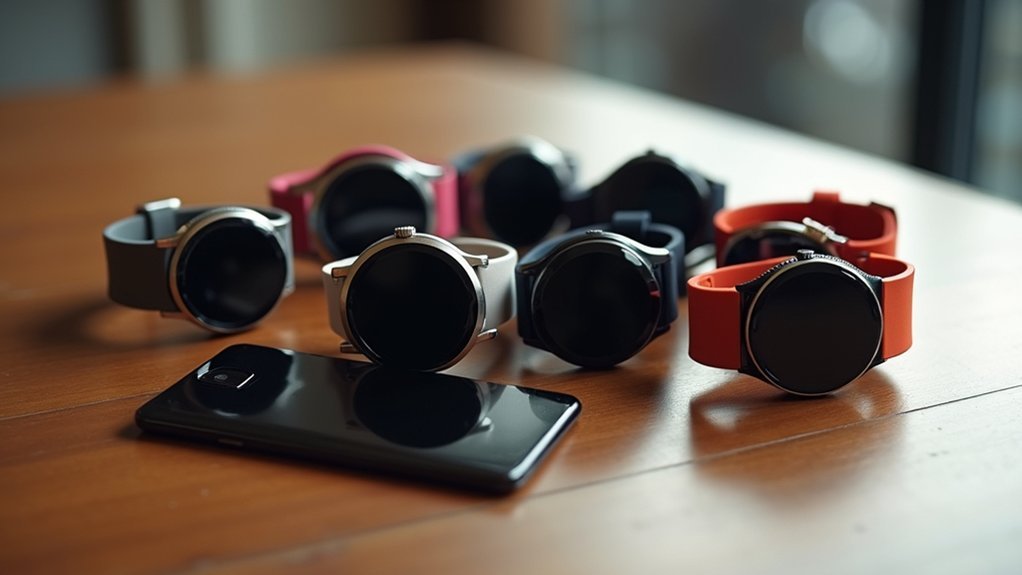
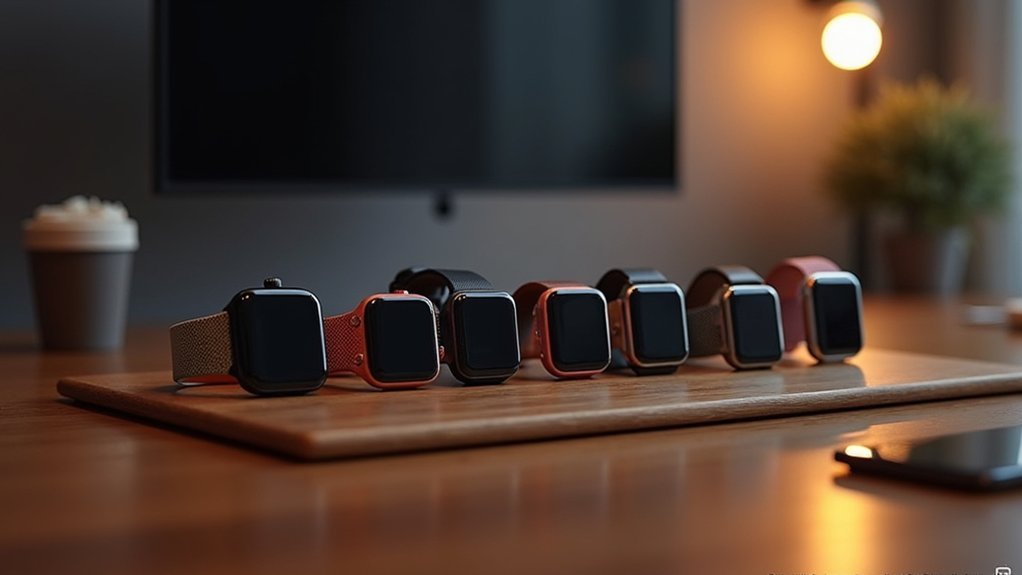
Leave a Reply